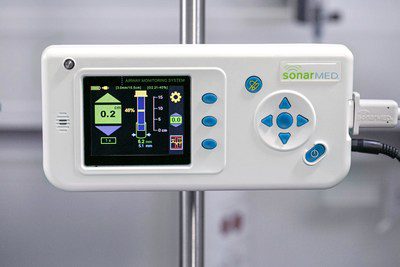SonarMed airway monitoring system is the first and only device of its kind.
SonarMed airway monitoring system utilizes acoustic technology to check for endotracheal tube (ETT) obstruction and verify position in real-time, giving clinicians vital information required to make more informed, life-saving decisions for their smallest patients.
Globally, 415,000 neonates and infants require invasive mechanical ventilation per year and are intubated for greater than 24 hours. Despite recommendations and reduction efforts, 75,000, or about one in five, of these neonates and infants will experience at least one unplanned extubation (UE). In the NICU, UEs are a significant safety concern for neonates and newborns and are the most common adverse event during mechanical ventilation.1 These events can lead to increased length of stay and hospital costs.2 Adoption of the SonarMed airway monitoring system can help reduce the frequency of these events, which in turn can help improve outcomes and reduce healthcare costs.
“The SonarMed airway monitoring device has revolutionized the way we care for our littlest patients. There is no other device in the world that can tell you where the endotracheal tube is located within the airway continuously in real-time, and whether the tube is obstructed or even partially occluded,” said Jamie W. Powers, M.D., MBA, neonatologist at Huntington Hospital in Pasadena, California.
He added, “At our hospital, this information has led to a drastic reduction in the number of x-rays performed and marked improvement in the effective suctioning of the airway. It also provides the care team and parents the added reassurance that the breathing tube is where it needs to be while repositioning the patient and during kangaroo care. In our institution it has become the new standard of care for all intubated infants.”
The SonarMed airway monitoring system is the first and only FDA-cleared airway monitoring system that provides timely notifications and specific measurements that help enable a coordinated response to address potentially critical events such as ETT movement and migration.
“Clinicians face unique challenges in the neonatal intensive care unit (NICU) and pediatric intensive care unit (PICU) daily, ranging from managing oxygenation within extremely tight ranges, to keeping family members informed and comforted. With our innovative technology, this fragile patient group is continuously monitored with a real-time and accurate device that may help improve a clinician’s ability to manage the airway and enhance outcomes for our smallest, most vulnerable critical care patients,” said Ariel MacTavish, president of the Respiratory Interventions business, which is part of the Medical Surgical Portfolio at Medtronic.
MacTavish concluded, “Our goal with introducing the SonarMed technology is to help solve a clinical need to reduce the number of unplanned extubations to help these vulnerable patients start their lives in the healthiest way.”
SonarMed, which was acquired by Medtronic in December 2020, specializes in developing solutions that increase patient safety while significantly decreasing healthcare costs.
“With Medtronic’s extensive market presence, clinical leadership, and market development expertise, coupled with SonarMed’s innovative technology, we are confident that together, we can potentially help save the lives of thousands of infants,” said Tom Bumgardner, strategic planning program director, Medtronic Respiratory Interventions, and former SonarMed CEO.
